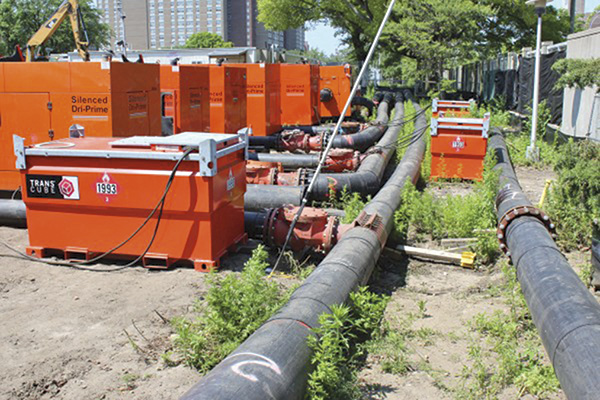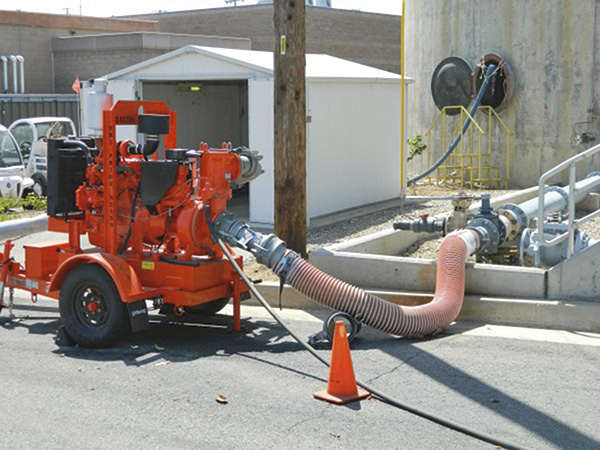Solids-handling capability is an important aspect of every jobsite and differs as much as any other factor in dewatering applications. Specifying the diameter of the solids is not the only factor to consider in pump selection. Another key factor is the type of solids being pumped. Typically, types include compressible solids (such as stringy sewage, bags and rags) and non-compressible solids (standard hard solids such as rocks).
Solids-Handling Applications
Solids handling is an important consideration anytime the water being pumped is not clean water. In construction applications, solids are often rocks, bricks, sticks and stones. Whenever demolition or building occurs, these materials may end up in the liquid being pumped on the jobsite. In mining applications, all these materials are possibly included, as well as fine rocks and fine abrasive material.
In municipal (water and wastewater) applications, the solids often include materials left behind by people working on the project. This can include many different items, but commonly includes stringy materials—such as trash, rags and large debris. Often, a pump that is capable of passing a certain diameter of solid cannot handle this stringy material because it winds around the impeller vanes and can cause clogging. However, the solid diameter of stringy material at a jobsite is often not as large as one would assume because these solids are compressible (think tennis ball versus cue ball).
How Pumps Pass Solids
A standard dewatering pump is capable of high volumes and medium-to-high head. These pumps pass large solids, up to five inches. These solids can include rocks, stones and bricks, like those discussed in construction applications.
 During a 10-year storm event, 15 solids-handling pumps, which are capable of pumping 3.5-inch, non-compressible solids, bypass a wastewater treatment plant’s flow.
During a 10-year storm event, 15 solids-handling pumps, which are capable of pumping 3.5-inch, non-compressible solids, bypass a wastewater treatment plant’s flow.The stringy solids that can occur in municipal applications can clog pump impellers. For those applications, a project should use an open-impeller pump. Closed impellers made of high chrome are often used to pump fluids with smaller solids. The solids pass through the impeller, which is the hardest material in the pump, instead of passing over the wear plate and eventually wearing this component.
Impeller Benefits
When considering construction applications, review the project’s pump impeller needs. An open or semi-open impeller, with an adjustable wear plate, offers more room for non-compressible solids to pass. Pumps with this impeller type are able to handle solids up to five inches in diameter, reducing the risk of clogging because of non-compressible solids. The open impeller design also means that these pumps can be used in a wide range of applications from water and wastewater to drilled muds and industrial fluids.
Cast steel is the best material of construction for open impellers because it provides excellent impact resistance when passing non-compressible solids, such as rocks. An open impeller, with a cutter vane, may not have large open passages like typical automatic self-priming pumps. However, for compressible solids, this type impeller can pull stringy solids through and pass them when other pumps may clog.
 A comparison of sustained efficiency over time of conventional pumps versus non-clog, open-impeller cutter vane pumps
A comparison of sustained efficiency over time of conventional pumps versus non-clog, open-impeller cutter vane pumpsIn applications with smaller solids, a closed impeller is another type to consider. A closed impeller is better equipped to handle abrasives—such as fine rocks and abrasive materials encountered in mining applications. Additionally, velocity can be a strong component of pump system design in mining applications, in which pumping includes slurries and non-compressible solids.
When considering a pumping application, keeping the product moving and avoiding clogging is paramount. Therefore, end users should always review the nature of the project’s solids before deciding on a pump design. They should determine if the solids are compressible (stringy sewage) or non-compressible (rocks, construction trash). For non-compressible solids, the open-impeller design (in which the leading edge of the impeller vanes do not terminate at the eye) allows for greater handling when coupled with an adjustable wear plate.
However, when pumping stringy sewage and compressible solids, a cutter-style, two-vane impeller, with vanes that terminate at the eye, will shred stringy material and eliminate the clogging often associated with sewage pumping.
Effects on Efficiency
Efficiency depends on the impeller design, although open impellers and those with cutter vanes share similar efficiencies. Pumps with impellers and cutter vanes are capable of running continuously over time without clogging. Considering the type of application (water velocity, sizing pipe correctly, etc.) is important rather than only considering the straight hydraulic efficiency.
 A non-clog, open-impeller pump takes suction from a pipeline that connects to the bottom of a digester. It is capable of pumping compressible, stringy solids.
A non-clog, open-impeller pump takes suction from a pipeline that connects to the bottom of a digester. It is capable of pumping compressible, stringy solids.Energy-efficient, diesel-powered engines—all of which meet emissions regulations—make conventional pumps ideal for applications on many jobsites. When stringy solids enter the inlet of a conventional pump, they can get caught on the leading edges of the impeller vane. This buildup may reduce the impeller’s efficiency and lead to increased power consumption and energy charges. An open impeller with a cutter vane sustains higher efficiency over time because it uses backswept vanes with a swept relief groove and effectively self-cleans. This means the system can run more efficiently and requires repair less frequently, keeping energy, fuel and repair/downtime costs low.
Size & Design Selection
Depending on the composition of the solids, oversizing the pump or oversizing the pipe and accessories are options to consider. In some cases, using bigger pumps at lower speeds may provide longer pump life, and larger diameter pipes may mean less friction loss. When high solids-handling capabilities are required, the pump needs to speed up to keep the solids in suspension because slurry moves much slower than the liquid.
If the pumping liquid has a high specific gravity, motor size is important. Consider sizing up the motor, since this liquid require mores horsepower than pumping clean water.
In high-wear applications—such as mining and tunneling—the goal is to remove the larger solids and pump water that is as clean as possible to extend the service life of the pump. This solids removal can be accomplished with screens on the suction side or filter bags on the discharge side.


